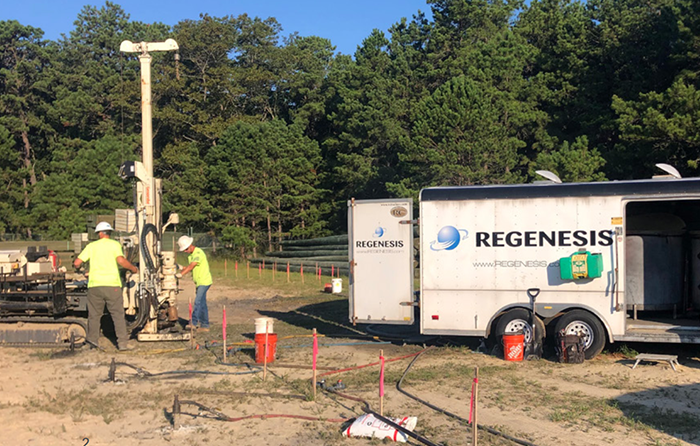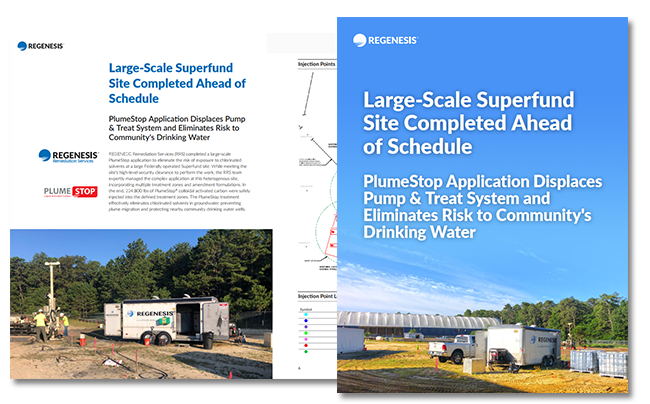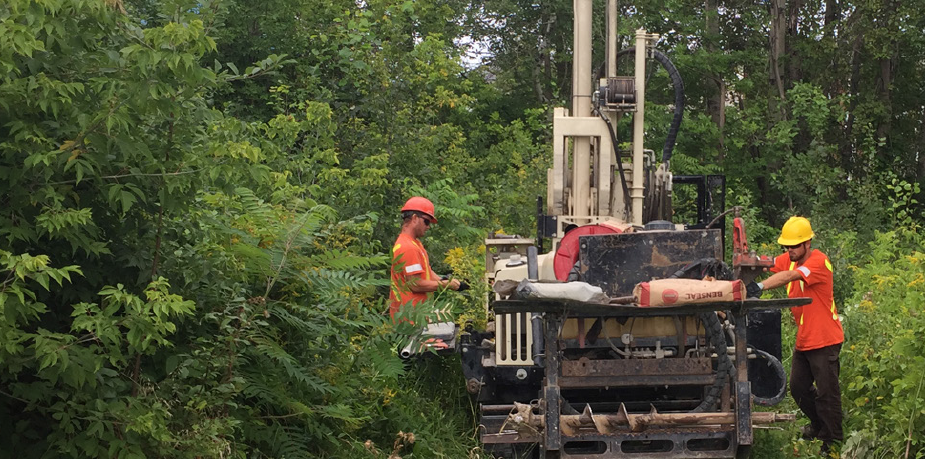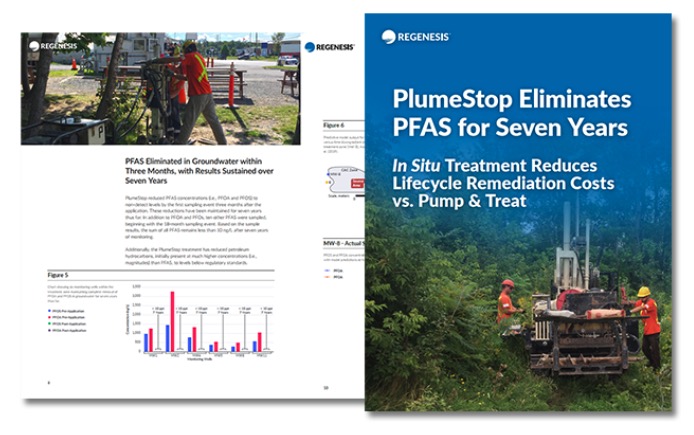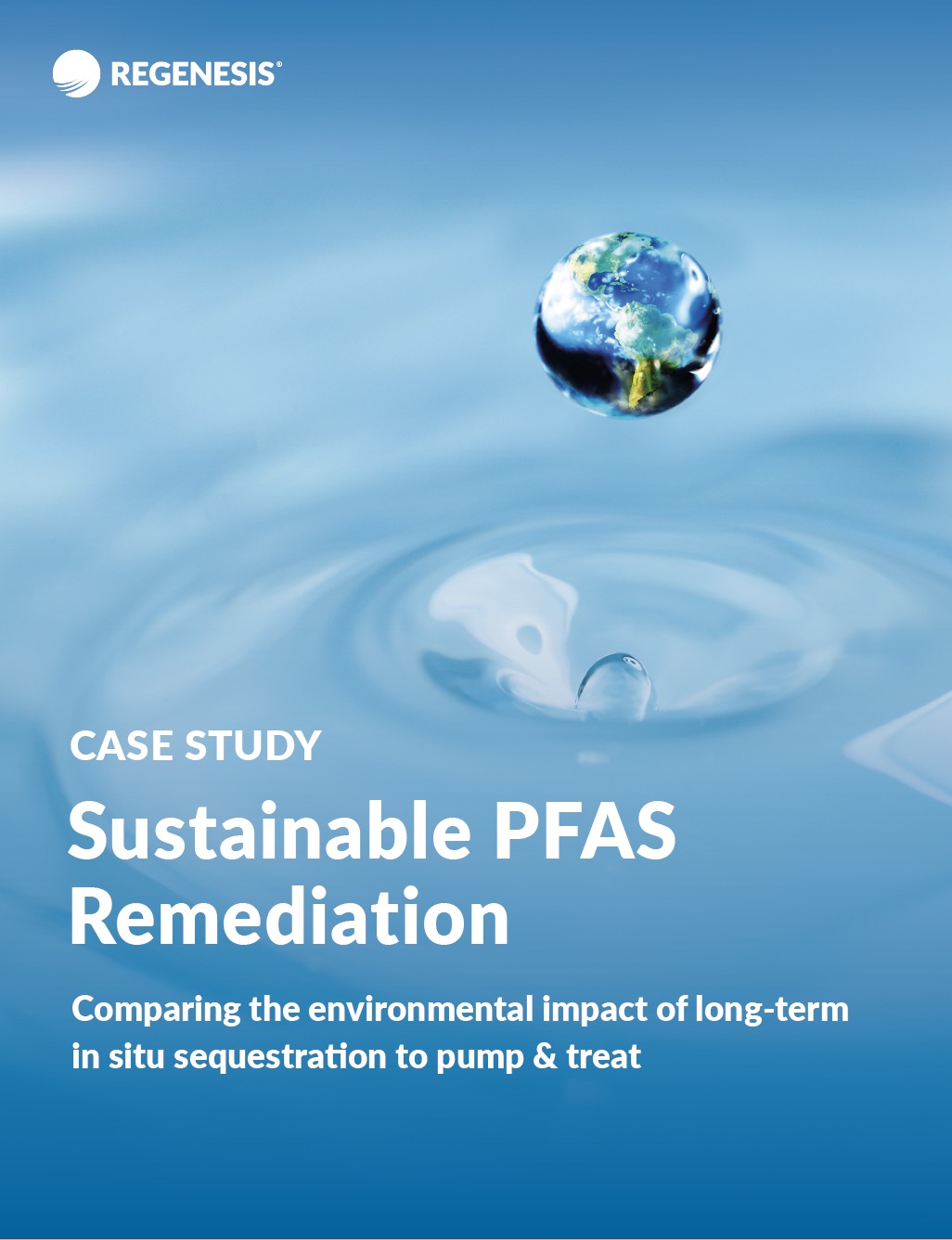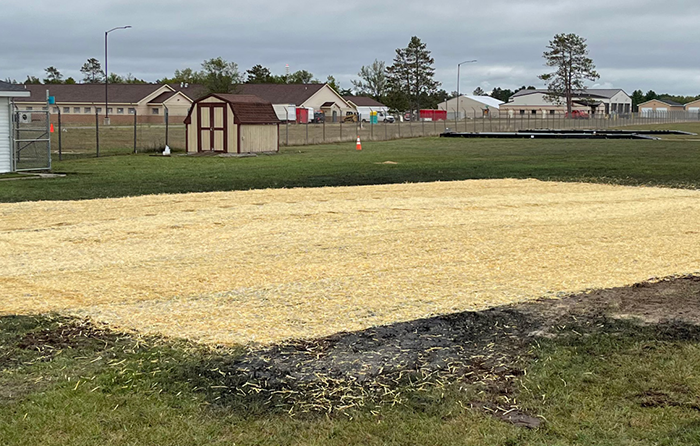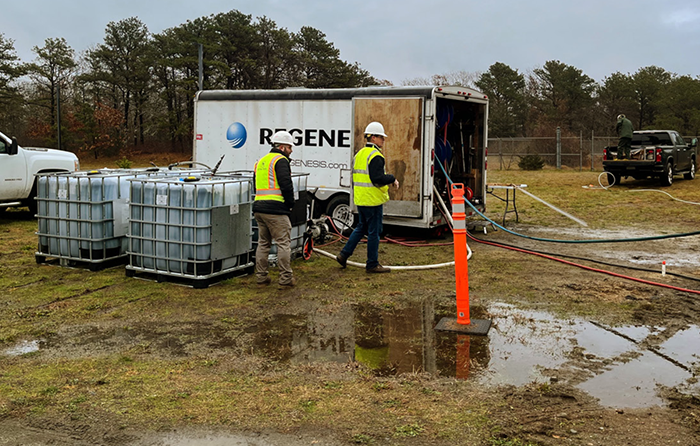PlumeStop Treatment Allows for Shut Down of Pump & Treat System
Case study highlights:
- PlumeStop treatment prevents plume migration and protects nearby community drinking water wells
- This sustainable approach eliminates the massive carbon footprint created by outdated pump-and-treat approaches
- 224,800 lbs. of PlumeStop colloidal activated carbon were safely injected into the target treatment zones
This case study reviews a large federally operated Superfund site in the USA where REGENESIS Remediation Services (RRS) completed a large-scale PlumeStop application to eliminate the risk of exposure to chlorinated solvents. Amentum, a leading American governmental and commercial services contractor, is the responsible party’s contractor. Amentum has worked with the client at this site for years, providing oversight and management of their contracting partners. The project’s sensitive nature required an enhanced awareness of health, safety, and security issues and seamless coordination between RRS, Amentum, and their client.
PlumeStop Eliminates PFAS for 7 Years
This case study reviews the first known full-scale in situ PFAS treatment worldwide completed in 2016 at a manufacturing and former firefighting training site in Ontario, Canada, where aqueous film-forming foams (AFFF) were used.
A single application of PlumeStop resulted in a significant reduction of contaminant concentrations to below standards for 7+ years since the injection.
Case Study Highlights
- PlumeStop application reduces PFAS to non-detect within 3 months, maintaining for seven years thus far
- Remediation company IRSL collects critical treatment zone information to ensure successful application
- Sampling confirms PlumeStop fully distributed through the treatment zone
- Third-party modeling indicates that PlumeStop will halt PFAS migration out of the treatment zone for more than 60 years
Sustainable PFAS Remediation: Comparing the environmental impact of long-term in situ sequestration to pump & treat
This case study gives an overview of the findings of a sustainability comparison study carried out by Ramboll where REGENESIS in situ sequestration approach with PlumeStop® has been compared to ex situ treatment of PFAS contamination using Pump & Treat with GAC and Pump & Treat with Foam Fractionation.
PetroFix Remediation under an Operational Petrol Filling Station
Injectable permeable reactive barrier prevents offsite risk
Fuel losses at an operational petrol filling station (PFS) in the UK resulted in light non-aqueous phase liquid (LNAPL) seasonally building up under the forecourt. High levels of dissolved phase contamination was shown to be migrating beyond the site boundary and providing a potential off-site liability.
It was decided that voluntary remediation should be completed to prevent offsite advection and SLR Consulting concluded that the most sustainable remedial design for the site would be the installation of an injectable permeable reactive barrier (IPRB) using PetroFix® colloidal activated carbon. SLR partnered with REGENESIS to design and apply the solution.
2m 27s reading time
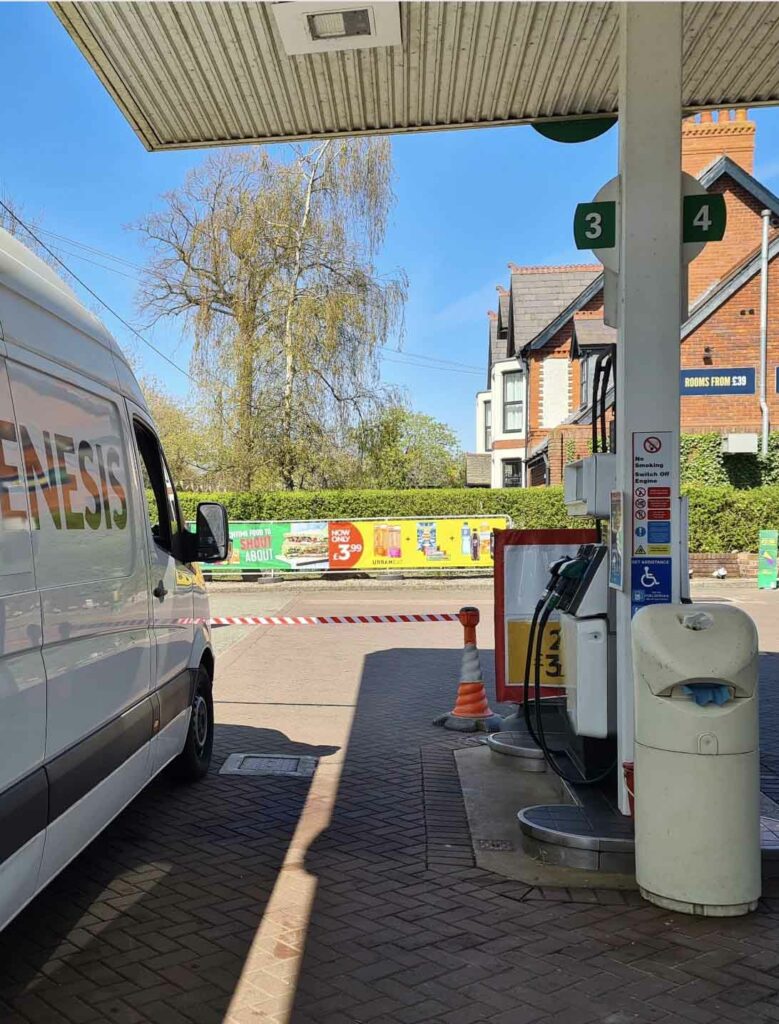
In Situ Chlorinated Solvent Treatment Protects Municipal Pumping Station
Remediation of a former dry cleaner site in Värnamo, Sweden
In situ remediation of groundwater impacted with high levels Tetrachloroethene (PCE) was completed at a former dry cleaning site, as the temporary installed groundwater recirculation system proved too expensive to run as a permanent solution. RGS Nordic carried out soil remediation using muliphase extraction and worked with REGENESIS to provide a remediation solution for the groundwater plume. Read the case study to find out about the remedial design, application and the results.
Highlights
- Example of a sustainable solution as no further operation cost or energy use required and it produced no waste for disposal
- Enhanced Reductive Dechlorination using a mix of REGENESIS electron donors delivers reduction in total chlorinated solvents of 99.6%
- 8 years of monitoring data shows no rebound in parent or daughter contaminant concentrations
- Downstream municipal pumping station is now protected from further contaminant ingress without the need for a protective pump & treat system
2m 39s reading time

In situ biogeochemical reduction solution for large TCE plume: Threat to river mitigated effectively
At a former manufacturing facility high levels of chlorinated solvents had been released into the groundwater, creating a large plume extending to the White River. A combined in situ biogeochemical reduction solution rapidly mitigated the threat to river and saved the client approx. $380,000 in project cost.
Wilcox Environmental Engineering, Inc. was hired by the responsible party to investigate the site. After evaluating the remedial options, Wilcox worked with REGENESIS to design a solution for in situ remediation of the TCE plume using biogeochemical reduction in the onsite plume area and sorption-enhanced chemical reduction in the offsite plume. This approach entailed placing permeable reactive barriers (PRBs) perpendicular to groundwater flow in strategic plume areas.
Case study highlights:
- Large TCE plume effectively treated using combined technology solution from REGENESIS, including PlumeStop and S-MicroZVI
- Accurate mapping of CVOC flux zones saves $380,000 in project costs
- Safe and efficient installation meets time and budget requirements
6m 38s reading time
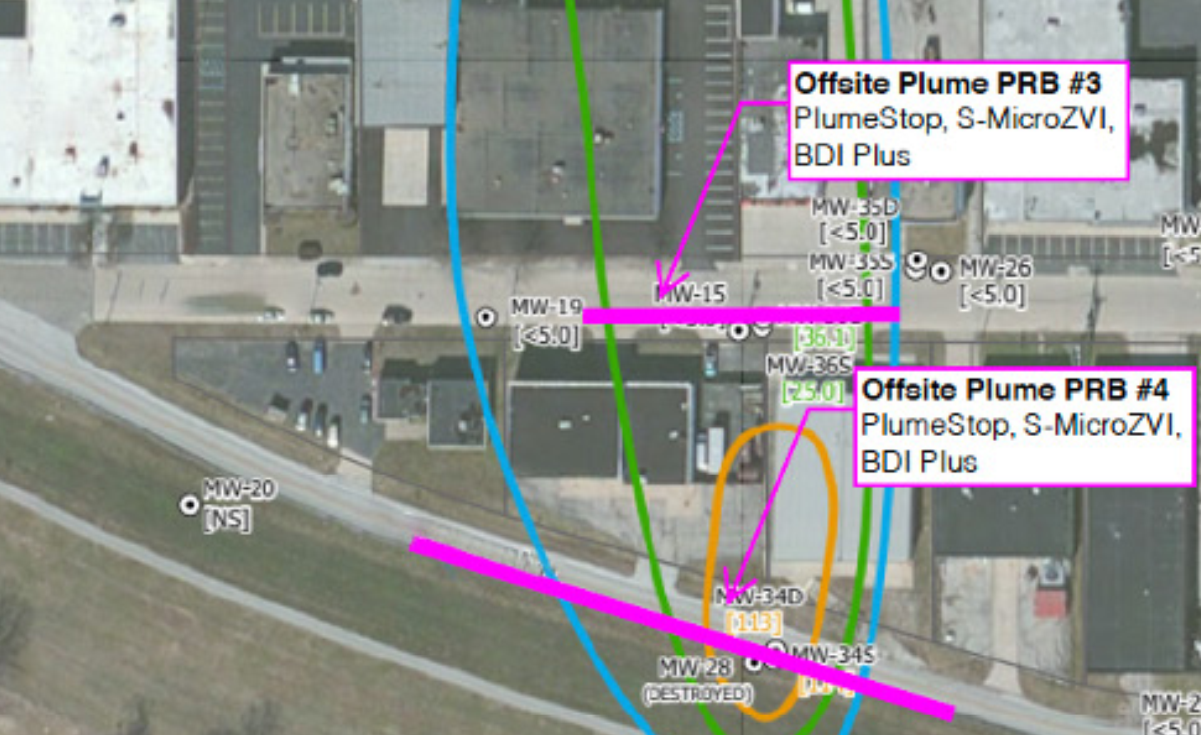
PlumeStop and S-MicroZVI Effectively Treat CVOCs to Expedite Site Closure
This case study reviews an active industrial facility where PlumeStop and S-MicroZVI successfully treated CVOC contamination. The combined remedy quickly reduced CVOC concentrations below targets, priming the site for future regulatory closure.
The responsible party retained Roux, a leading environmental remediation consultant, to complete the remediation project. Specifically, the remedy needed to (1) reduce CVOCs in soil, soil vapour, and groundwater to background contamination levels; (2) minimise disruption to the site tenant occupying the building; (3) coordinate with offsite property owners to complete the work; and (4) complete all work within established budgets and timeframes.
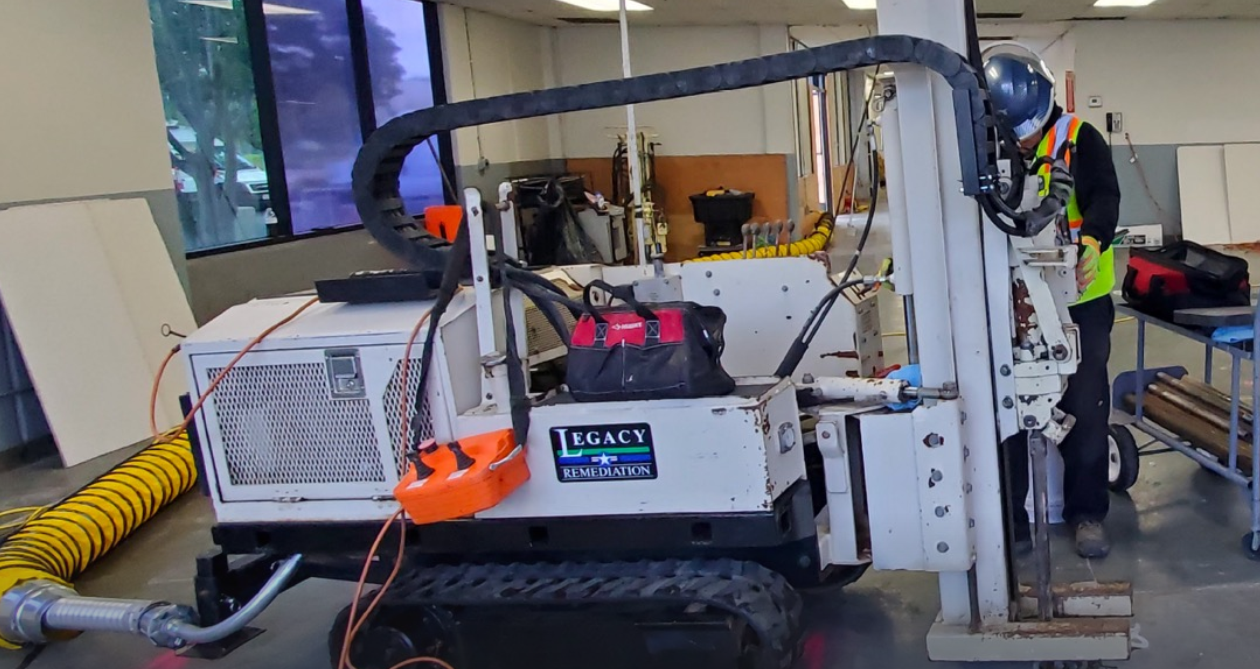
Case study highlights
- A multi‑faceted remedial solution mitigates CVOC contamination beneath an active business
- Successful application overcomes challenging site conditions
- Use of advanced colloidal remediation technologies from REGENESIS accelerates the project towards regulatory site closure.
10m 7s reading time
Sustainable and Low-Cost PFAS Source Treatment
Pilot Studies incorporating SourceStop horizontal barrier treatments demonstrate reduction of leaching
This case study reviews the in situ treatment of PFAS source zones at firefighting training areas on two aviation sites where PFAS-containing AFFF was historically discharged. Pilot tests at both sites demonstrated PFAS soil leachate concentrations has been reduced by >99% following the source zone treatments.
The PFAS source treatments applied site-specific amendment blends of SourceStop, a new concentrated form of colloidal activated carbon, in conjunction with powdered activated carbon. SourceStop is a micron scale aqueous carbon suspension emplaced as a horizontal PFAS barrier at the base of the target treatment zones to improve remediation effectiveness dramatically. In controlled laboratory studies, SourceStop has been proven to prevent PFAS leaching with >10x more effectiveness than powdered activated carbon alone.
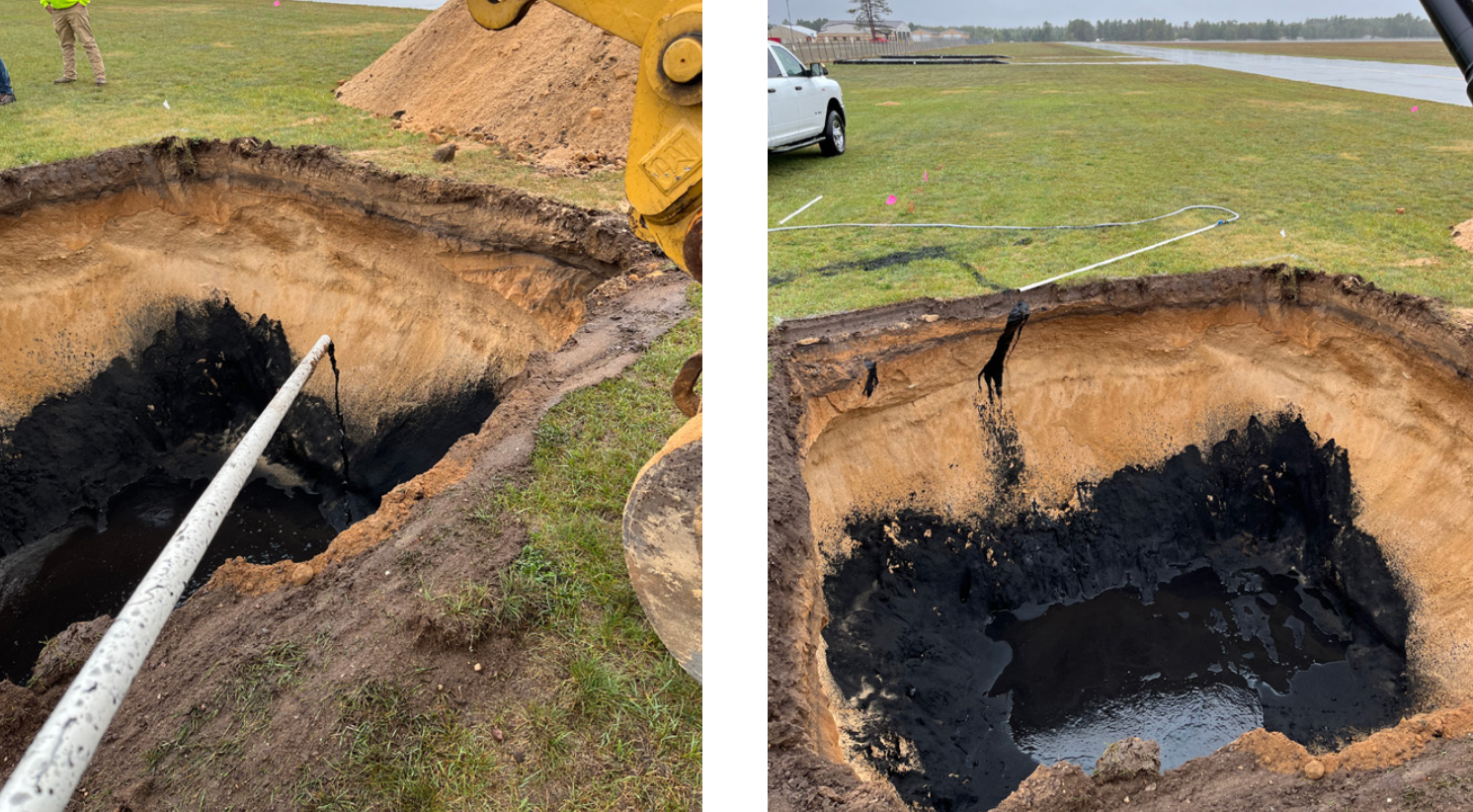
Case study highlights:
- In situ PFAS source treatments using SourceStop® immediately halt PFAS plume development and prevent impacts to downgradient receptors
- SourceStop approach is a sustainable remediation alternative compared to other mechanical and physical PFAS treatment methods
- Enhanced attenuation removes unacceptable PFAS exposure risk at a low cost
6m 33s reading time
Martha’s Vineyard Airport Successfully Treated Using PlumeStop to Eliminate PFAS Risk
This case study reviews a site at Martha’s Vineyard Airport where a PlumeStop barrier was used to treat PFAS. In less than four months, PlumeStop has eliminated PFAS mass flux immediately downgradient of the barrier and significantly reduced PFAS concentrations further away, as monitoring continues. The cost-effective and sustainable solution to remove PFAS exposure risk provides an alternative to expensive and ineffective pump & treat (P&T) systems.
Tetra Tech, a global environmental consulting firm, has worked with Martha’s Vineyard Airport over the years, addressing a dry-cleaning solvent release and other environmental issues at the site. At the request of the airport, Tetra Tech conducted an initial, preemptive PFAS assessment in 2018, confirming the presence of PFAS, commonly known as “forever chemicals” in groundwater. The remediation goal was to stop further PFAS movement away from the site. Tetra Tech opted for an in situ remediation approach. A PlumeStop injected permeable reactive barrier (PRB) was installed to passively filter PFAS out of groundwater, sorbing the contaminants onto the aquifer matrix and preventing further plume migration.
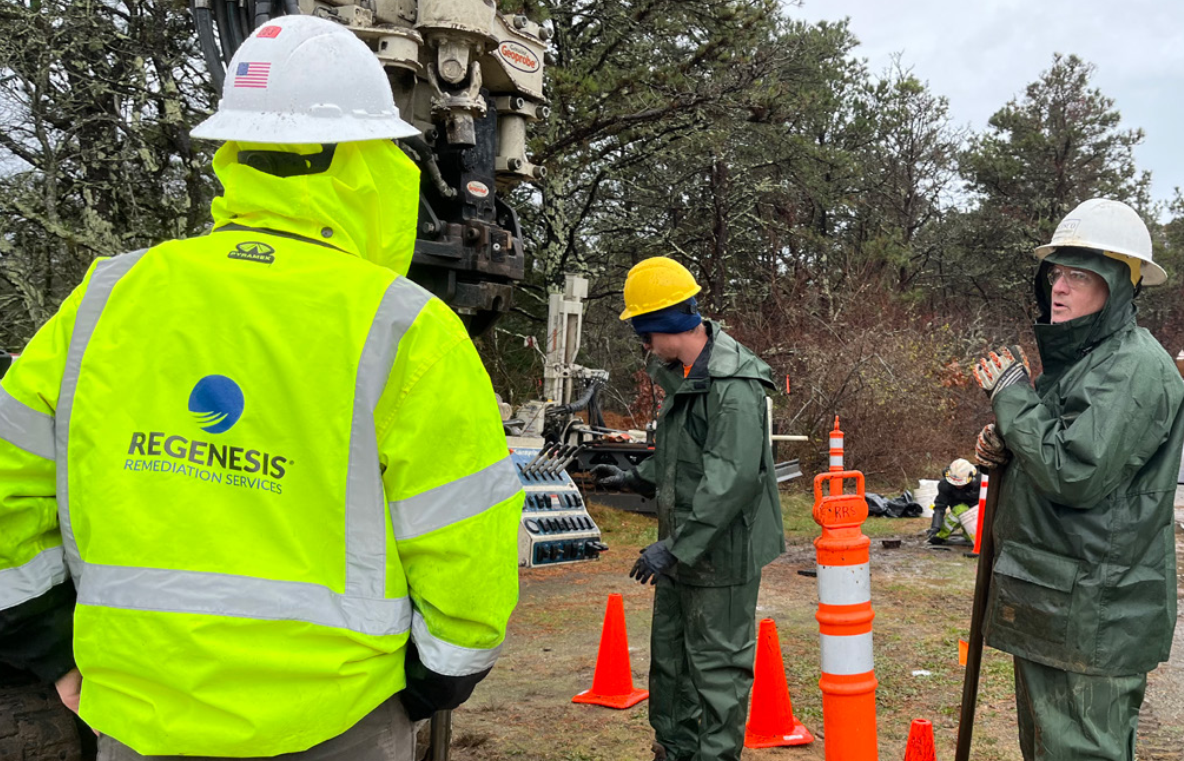
Case study highlights:
- Cost-effective in situ approach addresses PFAS risk, with no greenhouse gases or hazardous waste produced
- Contaminant flux measurements were obtained using FluxTracer, informing the PlumeStop dose required in the barrier to achieve the treatment objective
- Early performance data show PFAS mass flux eliminated downgradient of PlumeStop barrier, as monitoring continues
7m 16s reading time
Achieving site closure for a large PCE plume in urban area
This case study reviews a former dry cleaner site in a town in Indiana, USA, where site regulatory closure was achieved after a large dissolved-phase PCE groundwater plume was successfully treated using PlumeStop, enhanced reductive dechlorination (ERD) amendments and S-MicroZVI from REGENESIS. Patriot Engineering, a leading environmental consulting firm, specified ERD as the most practical and economically viable method to effectively treat the large plume.
Patriot’s strategy to achieve closure was to significantly reduce the PCE plume and then to demonstrate plume stability through post-remediation monitoring. By combining remediation technologies from REGENESIS with a highly efficient and cost-effective remediation design, Patriot’s treatment approach eliminated the PCE plume. Subsequent performance monitoring and analysis completed by Patriot demonstrated plume stability, earning the site a No Further Action status from the state regulator.

Case study highlights:
- Closure achieved for a large chlorinated solvent plume in an urban area
- A challenging site: located in an urban area with access limitations
- PCE sources rapidly eliminated and plume efficiently treated using a suite of REGENESIS in situ remediation technologies
11m 14s reading time

 Americas
Americas Europe
Europe Français
Français Deutsch
Deutsch Italiano
Italiano Español
Español